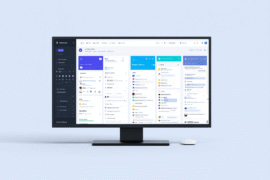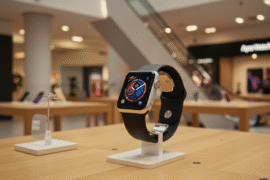This article may contain references to products or services from one or more of our advertisers or partners. We may receive compensation when you click on links to those products or services. Nonetheless, our opinions are our own.
The information presented in this article is accurate to the best of our knowledge at the time of publication. However, information is subject to change, and no guarantees are made about the continued accuracy or completeness of this content after its publication date.
Technology keeps changing quickly and becoming more and more a part of everyday life. Items that were once considered science fiction are now commonplace in both homes and businesses. One example of this is the rise of passive technology, which are new systems that work with very little energy. These tools promise to be more efficient and last longer. Often overlooked, display quality plays a crucial role in their performance. Vertical Gas Transition (VGT) technology, which is very important for passive tech, is having problems because the screens aren’t working well together. For users, developers, and manufacturers who want to make the most of usability and user satisfaction, it is important to understand this display problem.
- Knowing Passive Technology
- The Role of VGT in Passive Tech
- Why Display Technology Matters
- Innovation in Screen Technology
- Cross-Industry Collaboration
- The Path Forward for Consumers
- Checklist for Evaluating VGT Devices
- Why Screen Clarity Matters in Passive Tech Devices
- Conclusion
- Frequently Asked Questions
- Recommended Reads
Knowing Passive Technology
Passive technology encompasses systems that rely on natural processes instead of constant energy input. Common examples include solar panels and environmental sensors that function without frequent recalibration. The core benefits are sustainability, minimal maintenance, and long-term efficiency. Yet for these technologies to be practical and user-friendly, they must effectively communicate information. If a display is difficult to read due to low brightness or poor contrast, users may struggle to understand the device’s feedback. This hinders functionality and can reduce the perceived value of the technology.
The Role of VGT in Passive Tech
Vertical Gas Transition (VGT) technology operates by leveraging the physical behavior of gases to perform functions typically handled by energy-intensive systems. This makes it ideal for passive tech applications. However, VGT devices often fall short in one area: display performance. A high-functioning passive device may monitor environmental conditions in real time, but its usefulness diminishes if the display fails to communicate those changes clearly. Just as a fast vehicle needs a responsive dashboard, VGT requires a reliable display interface to complete the user experience.
Why Display Technology Matters
A high-quality screen serves as the bridge between advanced technology and end-user comprehension. It translates complex processes into readable, intuitive information. Without a capable display, users may overlook important alerts, misread data, or disengage from the device altogether. Modern display innovations such as OLED and e-ink offer sharper visuals and better readability. However, many VGT devices still rely on basic LCD screens, which often underperform in high-light or outdoor environments. This is particularly problematic in situations like kitchens, workshops, or exterior spaces where clarity is critical.
Innovation in Screen Technology
Several screen technologies can address the current limitations:
- OLED Displays: Known for vivid colors and deep contrast, OLEDs enhance readability and design appeal.
- Transflective Displays: These screens use ambient light for better visibility, making them ideal for outdoor use.
- Flexible Displays: Lightweight and adaptable, these are suitable for portable or compact VGT applications.
Integrating these technologies would significantly improve both the aesthetics and usability of passive tech devices.
Voted "Best Overall Budgeting App" by Forbes and WSJ
Monarch Money helps you budget, track spending, set goals, and plan your financial future—all in one app.
Get 50% OFF your first year with code MONARCHVIP
Cross-Industry Collaboration
Addressing this challenge requires more than improved hardware. Collaboration between screen designers, VGT engineers, and user experience experts can generate well-rounded solutions. Unified efforts can ensure that display technologies align with the operational strengths of VGT, delivering functional and enjoyable experiences for consumers.
The Path Forward for Consumers
Consumers entering the passive tech market should evaluate display quality as a key buying factor. Not all screens perform equally in different lighting conditions or usage scenarios. Assessing screen brightness, resolution, and responsiveness helps ensure that the device provides both performance and user-friendly interaction.
Checklist for Evaluating VGT Devices
When considering a VGT-enabled product, use the following checklist:
- Screen Type: Identify whether the device uses LCD, OLED, or another technology.
- User Reviews: Look for consistent feedback on screen visibility or brightness issues.
- Hands-On Testing: Whenever possible, test the device in-store under various lighting conditions.
- Update Roadmaps: Investigate whether the manufacturer plans to upgrade the screen in future versions.
Why Screen Clarity Matters in Passive Tech Devices
According to ISO (2020), good screens need to show clear and helpful information that matches what the user needs. This means the text and images should be easy to see and understand. NASA also recommends using enough contrast, at least a 3:1 ratio between text and background, so people can read the screen in different lighting. These rules show that screen quality, like brightness and sharpness, really matters, especially for tools that give updates in real time. Even when using energy-saving tech like OLED or e-ink, the display must still be easy to read. Following these recommendations helps ensure that users can genuinely trust and utilize low-energy passive devices.
Conclusion
VGT technology has the potential to change passive tech in a big way by making it more efficient and using less energy. But right now, screen limitations make it hard to get all of these benefits. The quality of the display is very important for both user experience and long-term use. Manufacturers can close the gap between innovation and usability by investing in modern screen solutions and encouraging cooperation between industries. Manufacturers need to realize that a great product is more than just its internal parts; it’s also about how it works with other things. Improving the display performance of VGT devices is no longer a choice; it’s necessary for growth, customer satisfaction, and long-term innovation.
Frequently Asked Questions
What is VGT and why is it important?
VGT stands for Vertical Gas Transition, a technology that uses gas-phase behavior to perform tasks with minimal energy input. It supports energy-efficient applications in both consumer electronics and industrial systems, making it valuable for sustainable design.
Why are screens a problem in current VGT devices?
Many VGT-enabled products use standard LCD screens, which often have low brightness, poor contrast, and limited readability in bright environments. These issues interfere with user interaction and reduce the overall utility of the device.
How does display quality affect user experience?
A poor-quality screen can make it difficult for users to read data, follow prompts, or access settings. This results in frustration and may cause users to abandon the technology altogether, regardless of its functional potential.
Which display technologies are better suited for VGT?
OLED, e-ink, and transflective displays are strong alternatives. They offer better contrast, improved readability, and energy efficiency. Each has specific advantages depending on the use case and environment.
What can consumers do before purchasing VGT tech?
Consumers should review product specifications, read feedback from other users, and test devices in person if possible. Ensuring the screen is readable and responsive is crucial for getting the most value from VGT-enabled technology.
Are manufacturers working on this issue?
Some manufacturers are beginning to explore improved display technologies, but progress remains uneven. Consumer demand and industry collaboration will likely accelerate development in this area.

Reviewed and edited by Albert Fang.
See a typo or want to suggest an edit/revision to the content? Use the contact us form to provide feedback.
At FangWallet, we value editorial integrity and open collaboration in curating quality content for readers to enjoy. Much appreciated for the assist.
Did you like our article and find it insightful? We encourage sharing the article link with family and friends to benefit as well - better yet, sharing on social media. Thank you for the support! 🍉
Article Title: Screen Quality Holds Back the Promise of Passive VGT Tech
https://fangwallet.com/2025/06/30/screen-quality-holds-back-the-promise-of-passive-vgt-tech/The FangWallet Promise
FangWallet is an editorially independent resource - founded on breaking down challenging financial concepts for anyone to understand since 2014. While we adhere to editorial integrity, note that this post may contain references to products from our partners.
The FangWallet promise is always to have your best interest in mind and be transparent and honest about the financial picture.
Become an Insider

Subscribe to get a free daily budget planner printable to help get your money on track!
Make passive money the right way. No spam.
Editorial Disclaimer: The editorial content on this page is not provided by any of the companies mentioned. The opinions expressed here are the author's alone.
The content of this website is for informational purposes only and does not represent investment advice, or an offer or solicitation to buy or sell any security, investment, or product. Investors are encouraged to do their own due diligence, and, if necessary, consult professional advising before making any investment decisions. Investing involves a high degree of risk, and financial losses may occur including the potential loss of principal.
Source Citation References:
+ Inspo
International Organization for Standardization. (2020). ISO 9241-110: Ergonomics of human-system interaction — Part 110: Interaction principles. https://www.iso.org/standard/77520.html NASA. (n.d.). Luminance contrast color guidelines. In Richardson, D. (2020), Color and contrast in e-learning design. Retrieved from https://jolt.merlot.org/vol10no4/Richardson_1214.pdf












































